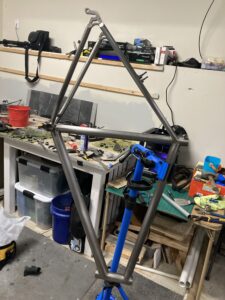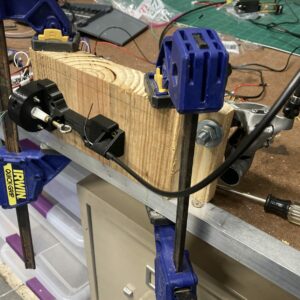Adding electronic shifting to a vintage bike


The Challenge
My pandemic hobby was bicycles. What started out as an innocent challenge from a mentor quickly ballooned into an (expensive) obsession. I had somehow managed to make it into my adult life without ever taking a bike apart. That’s pretty strange for me. Fixing (breaking) things is in my nature: My Jeep? down to nuts and rusty bolts. Computers? with a blindfold. Every device I’ve ever owned that’s stopped working? Yup. But a bicycle? I just never bothered. And for all of the jest in the challenge, there was something that troubled me about never completing even a basic tune-up.
Naturally, of course, what started as a basic tune-up turned into a full-blown overhaul. Subsequently, after building three bikes I’m here to tell some stories about some parts I’ve designed along the way. This post is the background story and the color-commentary to the DIY design work. In other words, the engineering will follow and, for those eager to see the designs, you can skip this content without missing much.
The Love


I get a lot of joy from riding bikes. The freedom of being on the road, the work required to get anywhere, and the slower pace of cycling are all elements of meditation for me. Many years ago, I foolishly decided to bike 1200 miles along Australia’s west coast. Afterwards, in the ensuing “adulting”, I totally forgot about how much I had loved that experience. Shortly after building my second road bike I remembered and decided I could do it again. This time with a better bike and (significantly) better equipment. Ultimately, I built a titanium touring bike and rode from Chicago to Dallas. And it was awesome.
The Need
But this is not a blog site about bike touring…although that would be super cool (interested? Start at the American Cycling Association). This is an engineering design site and this post is the first in a series about electronic shifting.
Yep, electronic shifting is already available. Nope, I didn’t come up with the idea. Shimano spearheaded their Di2 technology many years ago. Hobbyists and weekend-engineers have taken a few cracks at it also. But I wanted something different. For instance, my requirements were:
- Use of my existing, vintage rear derailleur;
- Non destructive modification;
- Long battery life (without the need for a 12 pound battery);
- Fully customizable.
Well, it turns out that those already exist too! For example, have a look at X-Shifter or Archer Components (note: no affiliate links here and X-shifter started as a Kickstarter campaign that was successfully funded. And, like many other hardware kickstarters, was also successfully abandoned).
*My* Electronic Shifting
Alright, well, I can just buy an off the shelf shifter and be done with it right? Eh, sort of. First off, I’m an engineer so I always think I can do it ‘better’. Secondly, I have a *lot* of electronics, motors, and general DIY stuff laying around the garage. Like borderline hoarder-level. Mostly though, I need projects to maintain my sanity. So this DIY project was as good as any. And it started with that age old question:
Can I do it more cheaply than the off-the-shelf solutions?
Bottom Line Up Front


No, I can’t. But it sure was fun to try. In truth, I did make an electronic shifter that is cheaper than all of the solutions listed above. However, I was only able to do this because I already had the components laying around. Mass producing these devices at scale involves costs that are not easy to re-coup. Kudos to these companies for achieving even this level of affordability.
Series Outline
Over the next few weeks (4-6 parts, I imagine) I’ll break out the engineering design process I took from wanting electronic shifting to having electronic shifting. In particular, I want to highlight:
- The proof of concept designs;
- The free body analysis and limitations of working with existing derailleurs;
- Free energy storage designs (also called neutral or static equilibrium designs);
- Why I think all of the current “retro-fit” designs are wasting more power than they need to.
Jesse DeWald
OwnerMr. DeWald is an engineer, educator, and problem-solver. He studied at The Cooper Union for the Advancement of Science and Art in New York City where he worked shoulder to shoulder with the best artists, architects, and engineers in the world. He has more than 14 years of industry experience in research and development, large-scale manufacturing, product design, and higher education.
He is currently the owner of DeWald Designs LLC.
